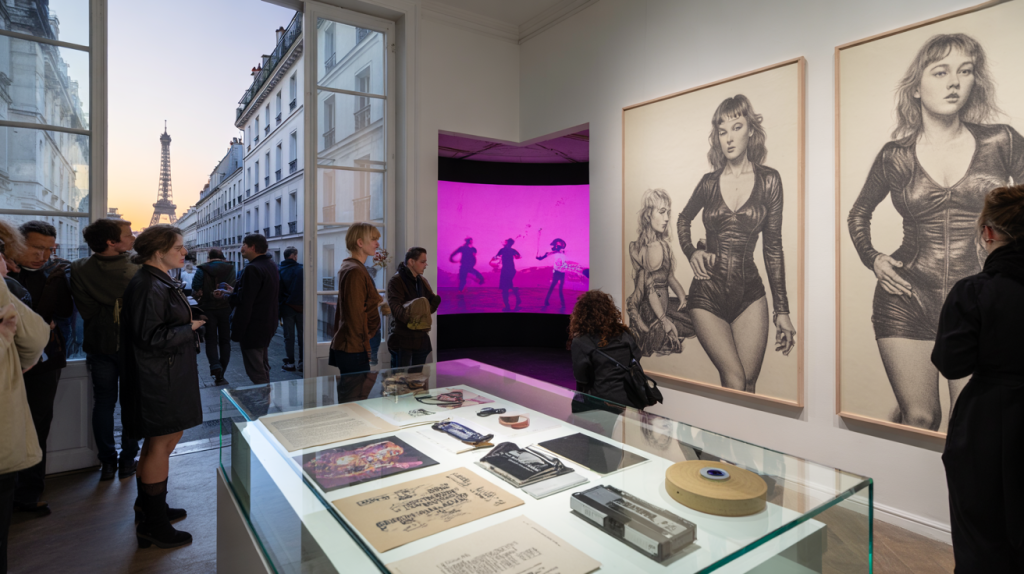Paris meets a pioneer. The exhibition dedicated to G.B. Jones places a singular voice from the queercore movement right in the heart of the city, where underground culture often flips into the mainstream. Visitors come for the sharp drawings and cult films, and stay for the raw energy that still bites today.
Context helps right away. G.B. Jones helped spark queercore in the mid 1980s with the zine “J.D.s”, launched in 1985 with Bruce LaBruce. Her Tom Girls drawings broke open the macho codes of erotic art starting in 1991. Add a filmography that shook DIY cinema in the 1990s and 2000s, and the Paris show lands with history at its back and an audience ready to look closer.
G.B. Jones exhibition in Paris, explained clearly
The idea is simple and compelling. An exhibition brings together drawings, zines and film materials that track more than three decades of work. The throughline is desire and defiance, observed with a pencil line that looks elegant at first glance, then subversive once the details register.
Visitors often look for where to start. The Tom Girls series tends to anchor the room. It reimagined the codes popularized by Tom of Finland, but with women in charge of the gaze and of the game. That pivot, initiated in 1991, still lands with force because it redraws the power map in just a few strokes.
Numbers speak. The zine “J.D.s” circulated from 1985 to the early 1990s, placing music, art and politics on the same page at a time when mainstream magazines barely acknowledged queer punk. Fifth Column, the Toronto band Jones co-founded in 1984, released three albums between 1985 and 1994, which keeps the music thread present in the show’s sound and cadence.
Why G.B. Jones matters now in Paris
The timing resonates. A 2019 peer-reviewed study of 18 major U.S. museums found that 87 percent of artists represented were male and 85 percent were white. That gap has narrowed slowly, but audiences still ask to see stories written from other angles. The Paris spotlight on Jones taps into that demand without any sermon. The work does the talking.
A film corner usually shifts the mood. “The Yo-Yo Gang” was released in 1992 and condensed the energy of a scene that refused to wait for permission. “The Lollipop Generation” premiered in 2008 after a long gestation that began in the mid 1990s, delivering a snapshot of DIY survival and pleasure that feels unexpectedly intimate in a gallery setting.
Here is the practical observation that often unlocks the visit. G.B. Jones builds tension between iconography and everyday gestures. A jacket, a pose, a smirk. The Paris context adds fashion literacy to the reading, which helps decode the surfaces while the politics quietly unfold underneath.
How to get the most out of a G.B. Jones show
Arrive with two lenses. First, the graphic one, to catch the tight composition and clean lines that make the drawings so disarming. Second, the cultural one, to place each image inside the network of zines, bands, clubs and collectives that gave it momentum in the late 1980s and 1990s.
Take your time with the zines. They compress evidence. Dates, flyers, interviews, and grainy photos show how ideas travelled before social media. It becomes easier to see why the work still hits today, because it was built to move across hands and cities, not just hang on walls.
A tip that sounds simple but works. Keep a small note of what changed your mind in the room. A single panel can do it. That kind of active viewing turns a quick visit into a conversation with the scene Jones shaped, and it stays with you after the doors close.
For those who want to go further, check the film screenings that sometimes accompany the drawings. A short Q and A can connect dots across decades in minutes. If tickets have been annouced, book early. Screenings tend to fill fast when word of mouth kicks in.
Last point to complete the picture. Follow the gallery’s calendar and the artist’s official channels for schedules and any late additions, including talks with historians or musicians linked to Fifth Column and the queercore network. That final piece often turns a strong visit into a full experience anchored in Paris, but wired to a global story that started in 1985 and never really stopped.
